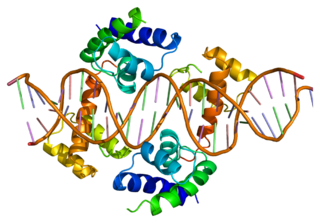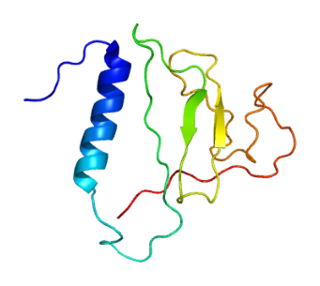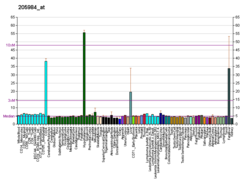
Corticotropin-releasing hormone (CRH) is a peptide hormone involved in stress responses. It is a releasing hormone that belongs to corticotropin-releasing factor family. In humans, it is encoded by the CRH gene. Its main function is the stimulation of the pituitary synthesis of ACTH, as part of the HPA Axis.
Corticotropin-releasing factor family, CRF family is a family of related neuropeptides in vertebrates. This family includes corticotropin-releasing hormone, urotensin-I, urocortin, and sauvagine. The family can be grouped into 2 separate paralogous lineages, with urotensin-I, urocortin and sauvagine in one group and CRH forming the other group. Urocortin and sauvagine appear to represent orthologues of fish urotensin-I in mammals and amphibians, respectively. The peptides have a variety of physiological effects on stress and anxiety, vasoregulation, thermoregulation, growth and metabolism, metamorphosis and reproduction in various species, and are all released as prohormones.

Urocortin is a protein that in humans is encoded by the UCN gene. Urocortin belongs to the corticotropin-releasing factor (CRF) family of proteins which includes CRF, urotensin I, sauvagine, urocortin II and urocortin III. Urocortin is involved in the mammalian stress response, and regulates aspects of appetite and stress response.
Urocortin 2 (Ucn2) is an endogenous peptide in the corticotrophin-releasing factor (CRF) family.
Corticotropin-releasing hormone receptors (CRHRs), also known as corticotropin-releasing factor receptors (CRFRs) are a G protein-coupled receptor family that binds corticotropin-releasing hormone (CRH). There are two receptors in the family, designated as type 1 and 2, each encoded by a separate gene.

POU domain, class 1, transcription factor 1 , also known as POU1F1, is a transcription factor for growth hormone.

Gonadotropin-releasing hormone receptor is a protein that in humans is encoded by the GNRHR gene.

Insulin-like growth factor-binding protein 2 is a protein that in humans is encoded by the IGFBP2 gene.

Corticotropin-releasing hormone receptor 1 (CRHR1) is a protein, also known as CRF1, with the latter (CRF1) now being the IUPHAR-recommended name. In humans, CRF1 is encoded by the CRHR1 gene at region 17q21.31, beside micrototubule-associated protein tau MAPT.

Corticotropin-releasing hormone receptor 2 (CRHR2) is a protein, also known by the IUPHAR-recommended name CRF2, that is encoded by the CRHR2 gene and occurs on the surfaces of some mammalian cells. CRF2 receptors are type 2 G protein-coupled receptors for corticotropin-releasing hormone (CRH) that are resident in the plasma membranes of hormone-sensitive cells. CRH, a peptide of 41 amino acids synthesized in the hypothalamus, is the principal neuroregulator of the hypothalamic-pituitary-adrenal axis, signaling via guanine nucleotide-binding proteins (G proteins) and downstream effectors such as adenylate cyclase. The CRF2 receptor is a multi-pass membrane protein with a transmembrane domain composed of seven helices arranged in a V-shape. CRF2 receptors are activated by two structurally similar peptides, urocortin II, and urocortin III, as well as CRH.

Acyl-CoA-binding protein in humans belongs to the family of Acyl-CoA-binding proteins.

Interleukin 10 receptor, beta subunit is a subunit for the interleukin-10 receptor. IL10RB is its human gene.

Urocortin-2 is a protein that in humans is encoded by the UCN2 gene.

Urocortin-3 is a protein that in humans is encoded by the UCN3 gene. It belongs to the corticotropin-releasing hormone family.

Transcription factor AP-4 , also known as TFAP4, is a protein which in humans is encoded by the TFAP4 gene.

Secretagogin is a protein that in humans is encoded by the SCGN gene.

Antalarmin (CP-156,181) is a drug that acts as a CRH1 antagonist.

High mobility group nucleosome-binding domain-containing protein 3 is a protein that in humans is encoded by the HMGN3 gene.
Corticotropin-releasing hormone binding protein (CRH-BP) binds corticotropin-releasing hormone (CRH) and several related peptide hormones. It is an ancient, highly conserved protein whose origin predates the divergence of protostomes and deuterostomes.
Sauvagine is a neuropeptide from the corticotropin-releasing factor (CRF) family of peptides and is orthologous to the mammalian hormone, urocortin 1, and the teleost fish hormone, urotensin 1. It is 40 amino acids in length, and has the sequence XGPPISIDLSLELLRKMIEIEKQEKEKQQAANNRLLLDTI-NH2, with a pyrrolidone carboxylic acid modification at the N-terminal and amidation of the C-terminal isoleucine residue. It was originally isolated from the skin of the frog Phyllomedusa sauvagii. Given its relation to other CRF-related peptides, it exerts similar physiological effects as corticotropin-releasing hormone.


















